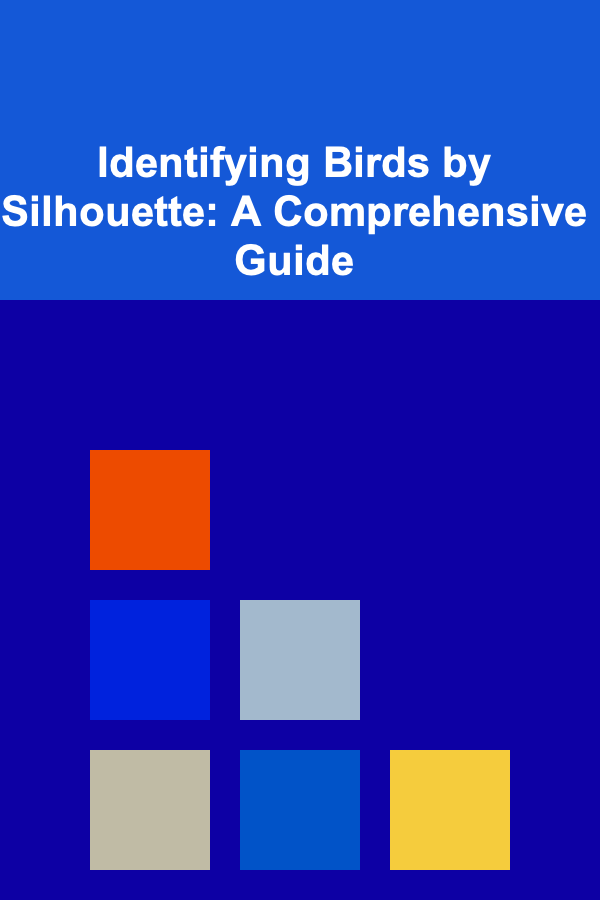
Identifying Birds by Silhouette: A Comprehensive Guide
ebook include PDF & Audio bundle (Micro Guide)
$12.99$7.99
Limited Time Offer! Order within the next:

Birdwatching is a rewarding hobby that connects us with nature and sharpens our observation skills. While detailed plumage is often the first thing birders notice, relying solely on color and patterns can be challenging, especially in poor lighting conditions or when birds are far away. A valuable skill for any birder, novice or expert, is the ability to identify birds by their silhouette. Learning to recognize a bird's shape against the sky or foliage provides a powerful tool for quick and accurate identification, even when other visual cues are limited. This guide will delve into the various aspects of avian silhouette identification, covering key features, common pitfalls, and practical tips for honing your skills.
Why Silhouette Identification Matters
There are several compelling reasons to master silhouette identification:
- Distance: Birds are often observed at considerable distances, rendering fine details like color and feather patterns indistinct. Silhouette identification allows you to make a preliminary identification, which can then be confirmed if the bird moves closer or conditions improve.
- Poor Lighting: In dawn, dusk, or heavily overcast conditions, colors are muted, making silhouette the most reliable clue. Think of identifying waterfowl against a grey sky -- shape is often your primary identifier.
- Rapid Assessment: Quickly recognizing a bird's silhouette allows for rapid species assessment, particularly important in situations where time is limited (e.g., during a migration count or when a rare bird flies by).
- Distinguishing Similar Species: Some species share very similar plumage but have distinct silhouettes. Learning these subtle differences can be crucial for accurate identification.
- Developing Observational Skills: Focusing on shape encourages a deeper level of observation and a more intuitive understanding of bird morphology.
Key Features to Observe in a Silhouette
Successfully identifying birds by silhouette hinges on paying attention to a range of features. These features work in combination, rather than in isolation, to create a distinct profile:
1. Overall Size and Proportions
Size is a fundamental starting point. Compare the silhouette to other objects in the environment or to your own knowledge of bird sizes (e.g., "smaller than a robin," "larger than a crow"). Beyond overall size, consider the proportions of the bird: is it long and slender, compact and round, or somewhere in between? Pay attention to the relative size of the head, body, and tail.
For instance, a Great Blue Heron appears significantly larger and more elongated than a Green Heron.
2. Body Shape
The general shape of the body is a crucial identifier. Is it streamlined, plump, upright, or horizontal? Consider the curvature of the back and breast. Is the bird's posture upright or leaning forward?
Owls often have a more rounded body shape than hawks, while hummingbirds have a characteristically small, streamlined body.
3. Head and Neck
The size and shape of the head and neck are highly diagnostic. Is the head large or small relative to the body? Is the neck long, short, thick, or thin? Look for any distinctive features like a crest, tufts, or a hooked beak.
The long, serpentine neck of a cormorant is a readily identifiable feature, as is the shaggy crest of a Northern Cardinal (male). A Turkey Vulture, when seen soaring, shows almost no neck at all. Their small, bare head appears directly attached to their body.
4. Beak Shape and Size
The beak is a critical element in silhouette identification. Notice its length, thickness, curvature, and overall shape. Is it long and pointed, short and conical, hooked, or flattened? The beak provides clues about the bird's feeding habits and can be highly specific to certain species or groups.
The long, decurved bill of a curlew or the stout, seed-cracking bill of a grosbeak are immediately recognizable.
5. Wing Shape and Flight Style
Wing shape and how a bird holds its wings while soaring or gliding are incredibly important. Wings can be long and pointed (characteristic of many raptors and seabirds), short and rounded (typical of forest birds), or broad and elliptical (common in soaring birds). Observe whether the wings are held flat, slightly angled upward (dihedral), or angled downward (gull-like). Also, note the flight style: Is the bird flapping rapidly, soaring effortlessly, or gliding with occasional flaps?
Turkey Vultures often soar with their wings held in a distinct "V" shape (a shallow dihedral). Swallows have long, pointed wings and a characteristic flight pattern of rapid, erratic movements. Eagles tend to soar with their wings held flat or with a very slight dihedral.
6. Tail Shape and Length
The tail is another key feature. Is it long, short, forked, square, pointed, or rounded? Does the bird cock its tail up or hold it straight out? The tail often serves as a rudder during flight and can be highly variable between species.
The long, forked tail of a Barn Swallow is unmistakable, as is the short, square tail of a Northern Flicker. A Brown Creeper often uses its stiff tail as a prop against tree trunks.
7. Leg Length and Position
Although often less visible than other features, leg length and position can be helpful, especially for wading birds. Are the legs long and trailing behind the body, or are they tucked up close? Can you see the legs extending beyond the tail during flight?
Herons and egrets have long legs that are often visible trailing behind them in flight. Ducks typically have legs that are positioned further back on their bodies, making them less agile on land but more efficient swimmers.
8. Posture and Behavior
A bird's posture and behavior can also provide clues. Is it perched upright, hunched over, or leaning forward? Is it actively foraging, preening, or simply resting? A bird's behavior can be indicative of its species or family.
Kingfishers often perch upright on branches, scanning for fish in the water below. Vultures typically perch with a hunched posture, waiting for carrion.
Examples of Silhouette Identification in Practice
Let's look at some specific examples to illustrate how to apply these features:
Example 1: Raptors
Raptors (birds of prey) often present a challenge, as their silhouettes can be similar. However, focusing on wing shape, tail length, and flight style can help differentiate them:
- Turkey Vulture: Large size, distinct "V" shaped wings when soaring, small head barely protruding beyond the wings, wobbly flight.
- Red-tailed Hawk: Medium to large size, broad wings, relatively short tail, soars in circles with wings held relatively flat.
- American Kestrel: Smallest North American falcon. Pointed wings, long tail (relative to body size), hovers frequently while hunting.
- Northern Harrier: Slender body, long wings and tail, flies low to the ground with a distinctive dihedral angle to its wings, giving it a "flappy" appearance. Often has a characteristic white rump patch, but this is not always visible in silhouette.
Example 2: Waterfowl
Waterfowl silhouettes can be tricky, but beak shape and head profile are often diagnostic:
- Canada Goose: Large size, long neck, relatively plump body.
- Mallard: Medium size, less bulky than a goose, characteristic bill shape.
- Bufflehead: Small duck, large, puffy head (especially in males). Often flies in flocks at low levels over water.
- Double-crested Cormorant: Long, slender neck often held in an "S" shape, flies low over the water with rapid wingbeats.
Example 3: Songbirds
Even small songbirds can be identified by silhouette with practice. Focus on body shape, tail length, and beak size:
- American Robin: Medium size, upright posture, relatively long legs.
- House Sparrow: Small, compact body, short tail, stout beak.
- Northern Cardinal (male): Distinctive crest, stout beak, relatively long tail.
- Eastern Phoebe: Wags its tail frequently. Sits upright on branches, often in an exposed position.
Common Pitfalls and How to Avoid Them
Silhouette identification is not foolproof, and there are several common pitfalls to watch out for:
- Light Conditions: Glare, backlighting, and other lighting issues can distort a bird's apparent shape. Try to adjust your position or wait for better lighting if possible.
- Angle of View: The angle at which you observe a bird can significantly affect its silhouette. A bird seen head-on will appear very different than one seen in profile. Try to observe the bird from different angles if possible.
- Distortions: Heat haze, fog, and other atmospheric conditions can distort silhouettes.
- Partial Views: If only part of the bird is visible (e.g., obscured by foliage), it can be difficult to get a complete picture of its silhouette.
- Immature Birds: Young birds may have different proportions than adults, making identification more challenging.
- Relying on a Single Feature: Avoid relying solely on one feature (e.g., tail length) for identification. Use a combination of features for a more accurate assessment.
- Lack of Experience: Silhouette identification takes practice. Don't be discouraged by initial difficulties. Keep observing and comparing silhouettes, and you'll gradually improve your skills.
Tips for Improving Your Silhouette Identification Skills
Here are some practical tips to help you hone your silhouette identification skills:
- Practice Regularly: The more you practice, the better you'll become. Make a conscious effort to observe bird silhouettes whenever you're out birding.
- Use Field Guides and Online Resources: Many field guides include silhouette illustrations, which can be a valuable aid. There are also numerous online resources that offer silhouette quizzes and identification tips.
- Focus on Common Species: Start by learning the silhouettes of common birds in your area. This will give you a foundation for identifying less common species.
- Compare and Contrast: When you see a bird silhouette, compare it to the silhouettes of similar species. What are the key differences?
- Take Notes: Keep a record of the silhouettes you observe, along with any distinguishing features. This will help you track your progress and identify areas where you need more practice.
- Sketch Silhouettes: Sketching silhouettes can help you internalize the shapes and proportions of different birds.
- Use Binoculars or a Spotting Scope: Binoculars or a spotting scope can help you get a clearer view of a bird's silhouette, even at a distance.
- Consider Habitat and Location: The habitat in which you see the bird (e.g., forest, field, wetland) and the geographic location can narrow down the possibilities. A seabird silhouette seen inland is likely a rare occurrence.
- Study Bird Anatomy: Understanding the basic anatomy of birds will help you better appreciate the relationship between body shape and species identification.
- Join a Birding Group: Birding with experienced birders can be a great way to learn new skills and get feedback on your identification.
Advanced Techniques
Once you've mastered the basics of silhouette identification, you can move on to more advanced techniques:
1. Identifying Birds in Flight
Identifying birds in flight requires even more attention to wing shape, flight style, and overall behavior. Pay close attention to how the bird flaps its wings, glides, and soars. Does it fly in a straight line, or does it weave and bob? The flight patterns can be very distinctive.
2. Recognizing Subtle Differences
Distinguishing between similar species often requires recognizing very subtle differences in silhouette. For example, differentiating between various gull species based on silhouette can be challenging, but careful observation of beak shape, wing length, and tail shape can help.
3. Using Sound in Conjunction with Silhouette
While this guide focuses on visual identification, combining silhouette observation with auditory cues (bird songs and calls) can significantly improve your accuracy. A distant silhouette coupled with a distinctive song can often lead to a confident identification.
Conclusion
Identifying birds by silhouette is a valuable skill that can greatly enhance your birdwatching experience. By paying attention to key features such as size, shape, beak, wings, and tail, you can learn to recognize a wide variety of birds, even in challenging conditions. Remember to practice regularly, use available resources, and be patient with yourself. With time and dedication, you'll develop a keen eye for silhouette identification and unlock a new level of appreciation for the avian world.

How to Create the Illusion of More Space in a Tiny Apartment
Read More
How to Have a Fun Family Cooking Challenge with Simple Ingredients
Read More
How to Transform Your Bedroom into a Winter Wonderland for the Holidays
Read More
Exploring the Truth Behind the Bermuda Triangle Mysteries
Read More
Blockchain for Voting Systems: A Comprehensive Analysis
Read More
How to Conduct a Workday Audit Checklist
Read MoreOther Products

How to Create the Illusion of More Space in a Tiny Apartment
Read More
How to Have a Fun Family Cooking Challenge with Simple Ingredients
Read More
How to Transform Your Bedroom into a Winter Wonderland for the Holidays
Read More
Exploring the Truth Behind the Bermuda Triangle Mysteries
Read More
Blockchain for Voting Systems: A Comprehensive Analysis
Read More